Why do lesbians divorce more often?
Average couple psychopathology is higher
Yes I know you are waiting for the exposition on the new admixture results (I too am excited), but first something else.
I, Hypocrite has this viral post on X:
The figure has been redrawn but the results check out (Comparative Couple Stability: Same-sex and Male-female Unions in the United States, 2019). The original is:
This version shows that there is a very large difference between merely cohabiting and formal relationships ("marriage, domestic partnership, or civil union" depending on local laws). The problem is that different kinds of relationships are not equally likely to be formalized:
However, the differences observed by sex-combination cannot be explained solely in these terms because male-male relationships are the most stable, whether formalized or not. Lesbians have a slight advantage over heterosexuals among unformalized relationships, but taking a weighted mean would still show they are they are at a disadvantage in general.
These findings aren't new either. The authors provide a helpful table of other large-scale studies examining the same question:
Of these, the population studies from Norway and Sweden are the best since they cover everybody in the country. So let's look at Andersson 2006:
Their results only replicate the American results (which is from The How Couples Meet and Stay Together (HCMST) survey, note this sample was examined in multiple studies listed above) in part because the gays were more likely to dissolve their relationships than heterosexuals (relative rates of 1.35, 3.03 respectively, i.e., +35% and +203%). Note also that inter-ethnic relationships were less stable, something I have discussed before (even among fellow Nordics!). Note also that the table above is only for Sweden, because the Norwegian results for some reason didn't include heterosexuals as a comparison. It produced the same lesbian>gay pattern though.
Their results also show that the usual demographic variables cannot explain these patterns. Controlling for age, age gap, region, ethnicity/birth country, and educational attainment didn't make much difference (the numbers are a bit different, but CIs strongly overlap). Neither did controlling for number of children matter.
So what does explain the pattern? First off, we need to realize that the meme posting (of which I am also guilty) fell for the lack of confidence intervals issue, taking the apparent lower gay rate as real, whereas it was not and their rate is in fact somewhat higher than heterosexuals. If we look at their models, we see this:
The gay rate differences are all within chance findings (no SEs given but there are no asterisks meaning p > 10%). Only the lesbian finding seems trustworthy (p < .01 in model 6). Strangely, the figures above are based on models 2 and 5 instead of 3 and 6. Anyway, my proposed explanation may still be approximately true:
To simplify things, the best predictor of divorce is the amount of neuroticism in the relationship. With two women, you get more than average, and with two men, less than average. Consequently, lesbian couples are less stable and gay couples more stable than heterosexual ones.
It comes down to the question: do pairs of gays have higher average neuroticism than heterosexuals? I found a large study of big give (OCEAN) personality by Lippa 2006, which reported these values:
Hetero men vs. women: 0.48 d neuroticism
Homo vs. hetero men: +0.20 d
Homo vs. hetero women: -0.30 d
Taking these values for granted, and setting hetero men to 0:, we can compute means as:
Hetero men: 0 [ref. group]
Homo men: 0.20 d
Hetero women: 0.48 d
Homo women: 0.48-0.30=0.18 d
Heterosexual couple: (0 + 0.48)/2 = 0.24
Gay couple: 0.20
Lesbian couple: 0.18
It turns out the averages come out about the same, so the neuroticism model predicts essentially nothing.
Maybe the idea is correct, but we need to dig deeper into mental health measures as opposed to self-reported neuroticism. Here's the very large All of us study with diagnoses by sex and orientation:
Unfortunately, they do not provide counts for any disorder or any general psychopathology score. We can make a pseudo total score by summing the diagnoses, which gives us:
Heterosexual men = 43.8
Heterosexual women = 58.7
Sexual minority men = 71.1
Sexual minority women = 90
(It's pseudo because many of these diagnoses occur in the same people and this approach assumes they are non-overlapping.)
The main issue here is that only 69% of the sexual minority men were gay (so they said anyway) as opposed to bisexual (26%) or something else, and for women only 27% (59% bisexual). Using these values anyway makes further assumptions. In any case, plugging these values into the same couple model from before yields:
Heterosexual couple: (43.8 + 58.7) / 2 = 51.2
Gay couple: 71.1
Lesbian couple: 90
The order now lines up with the divorce rates we saw before. Since these aren't proper scores, it is probably not wise to calculate any ratios based on these pseudo total scores. As a replication, I looked in the OKCupid dataset, which has 5 questions related to mental health:
These are the means:
Using these, we can compute the couple means:
Hetero male: 0
Hetero female: 0
Homo male: 0.16
Homo female: 0.29
Heterosexual couple: 0
Gay couple: 0.16
Lesbian couple: 0.29
Thus, we obtain the same rank order of the couple types. Better perhaps would be to download Aella's dataset and compute better global scores (exercise left for the reader).
With regards to the general model of more neuroticism -> more divorce, there's Solomon et al 2014:
The first table shows I think average personality (their methods are not clear), which shows that neuroticism and openness predict dissolution with roughly equal effect sizes (0.30 logits). The specific p-values aren't given, but you can mentally just look at the z- or t-values, and conclude that anything above 4 is a reliable finding, around 2 (p=5%) is a maybe. The second table predicts relationship satisfaction, which is a more continuous and more statistically reliable quantity (but is self-reported). Here the same predictors work for both partners (neuroticism and openness [NO] bad, EAC good). Of interest are the interactions, which since female = sex, the values are the female effects on top of male reference. Of these interactions, only female neuroticism is a reliable finding (t = 4.2) for the index person, while strangely, for the partner female neuroticism predicts slightly positive relationship satisfaction (t = 1.97 which is meh tier). As such, we see that taken broadly, these results support the idea that we can add up neuroticism in a relationship to predict its dissolution or dissatisfaction leading to eventual dissolution.
I think this is a sensible, simple model. The self-reported personality ratings from Lippa didn't match the theory, but the OKCupid scores did and so did the diagnoses from All of us. I think the diagnoses are more reliable. Better then would be a study of mental health problems in both spouses and dissolution. Such a study exists too Butterworth & Rodgers 2008:
In their words:
The results of this study showed that couples in which either men or women reported poor mental health at baseline had greater rates of marital dissolution than couples in which neither spouse experienced mental health problems. Those couples in which both spouses reported mental health problems had much higher rates of subsequent marital disruption, but this reflected the additive combination of each spouse’s separate risk and there was no additional risk arising from the co-occurrence of mental health problems in both spouses. The inclusion of covariates did not explain the association between men’s mental health and relationship disruption, though their inclusion and particularly the inclusion of relationship (dis)satisfaction in the model, accounted for much of the association between women’s mental health and divorce
Thus, the general model is also supported by direct measures of mental health diagnoses and dissolution, and the effect was additive thus, we can just think of the mean level of mental health issues in a given relationship.
Taking all of this together, the simple explanation for lesbians relative instability is that they are more prone to (other) mental health problems than gays are, presumably because they have the double effect of both being women and being non-heterosexual. An additional complication here is that lesbian relationships may involve relatively larger numbers of bisexuals, who have even higher rates of mental health problems than homosexuals (for reasons unknown). This would tend to further increase the mean psychopathology in lesbian couples relatives to gay couples and heterosexuals which is also in line with the model.


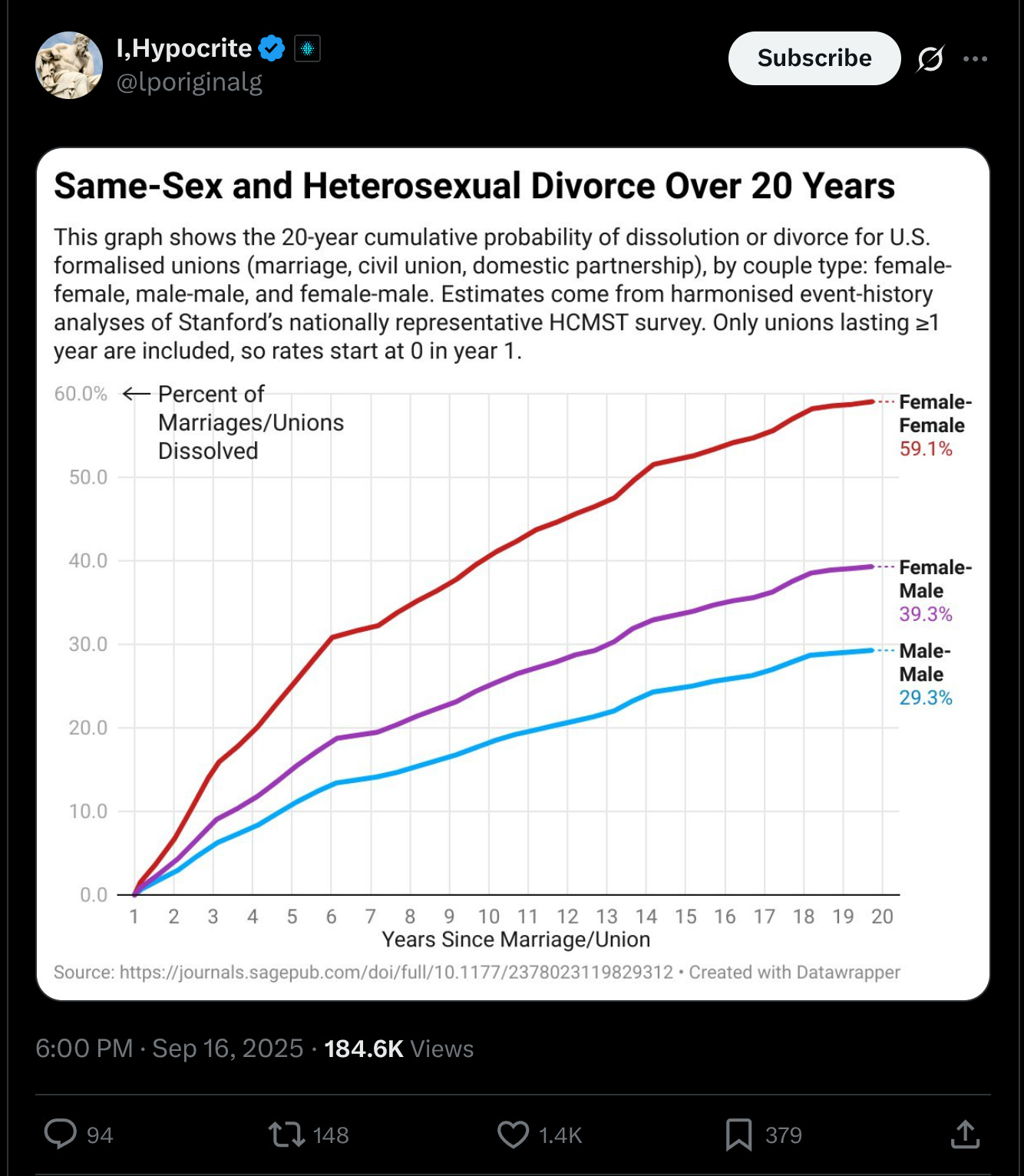
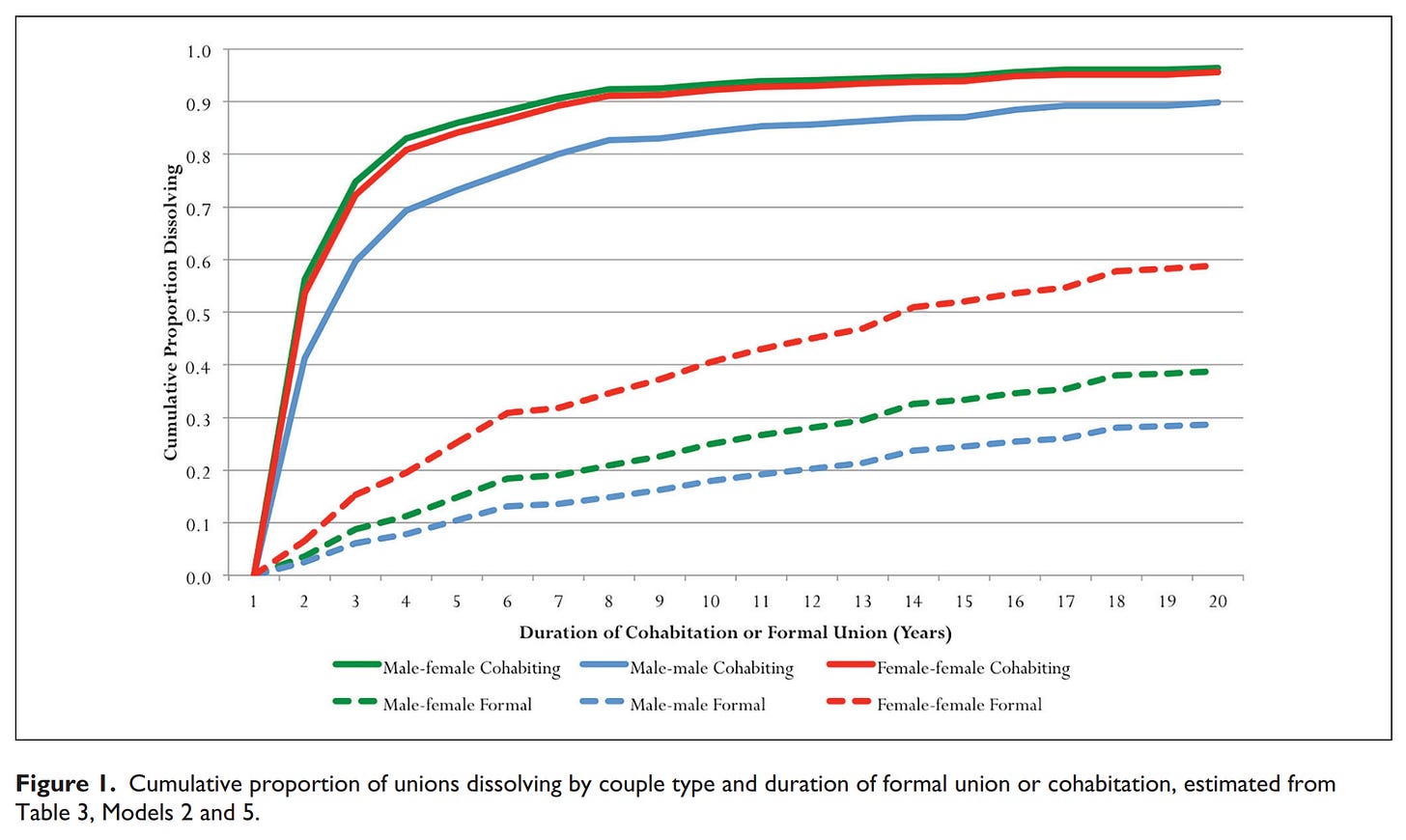

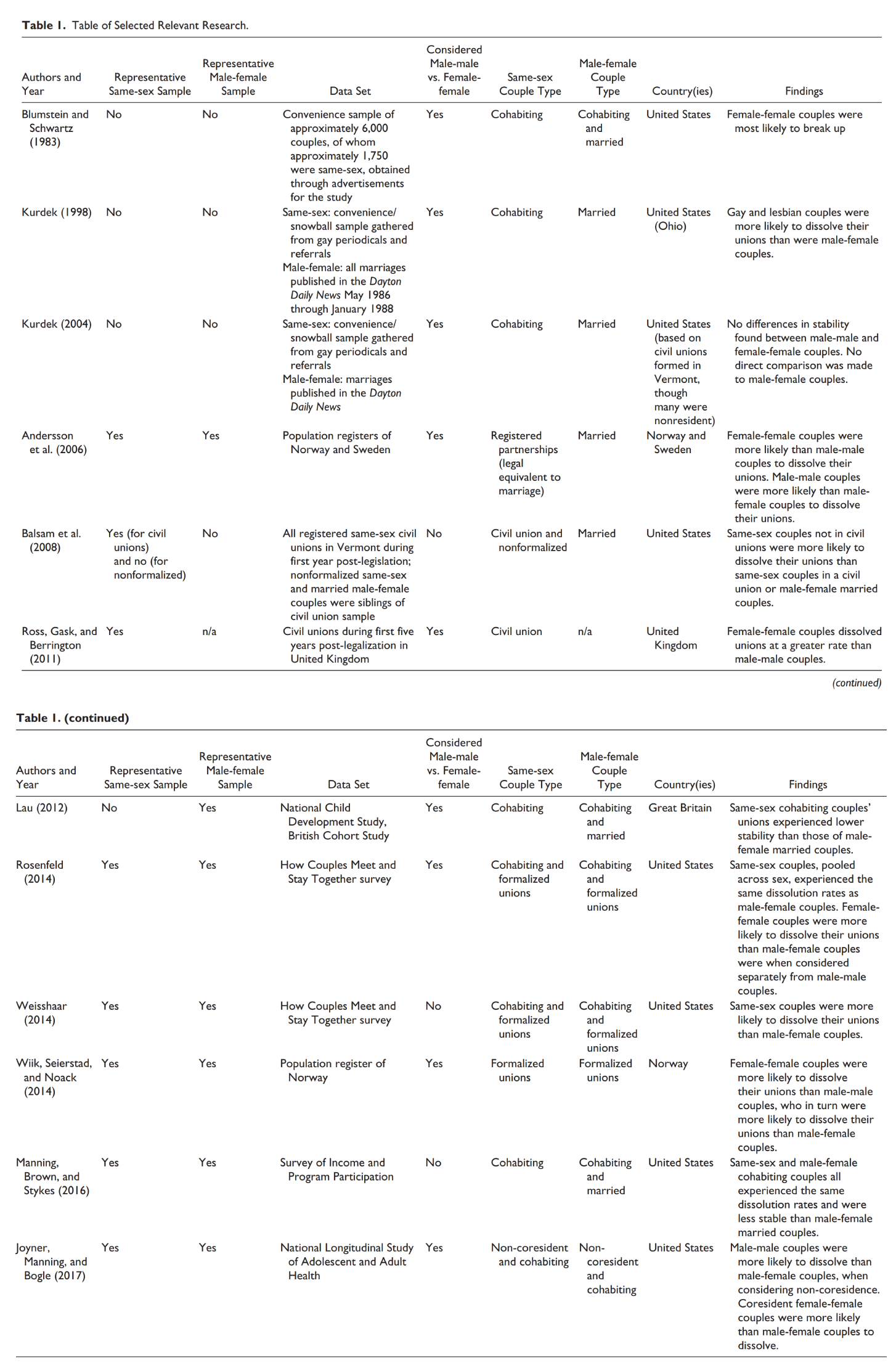

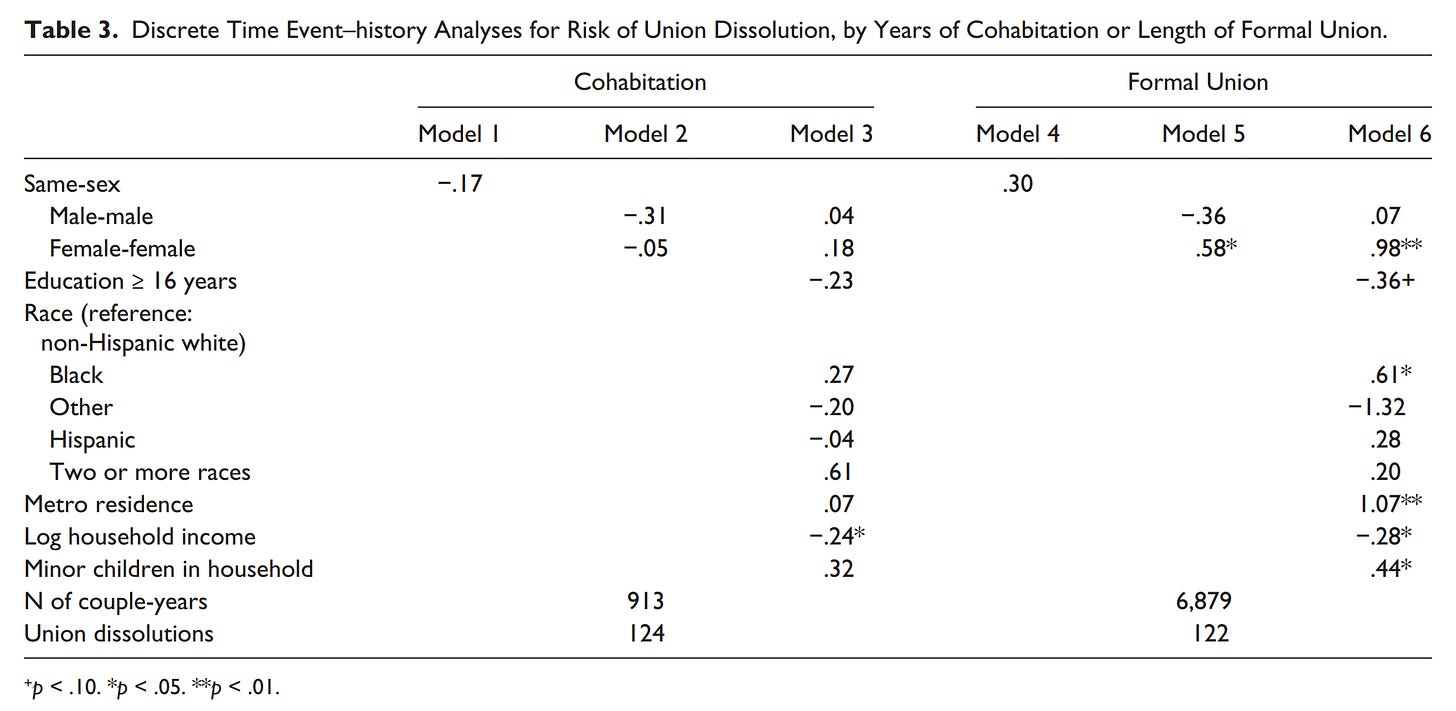
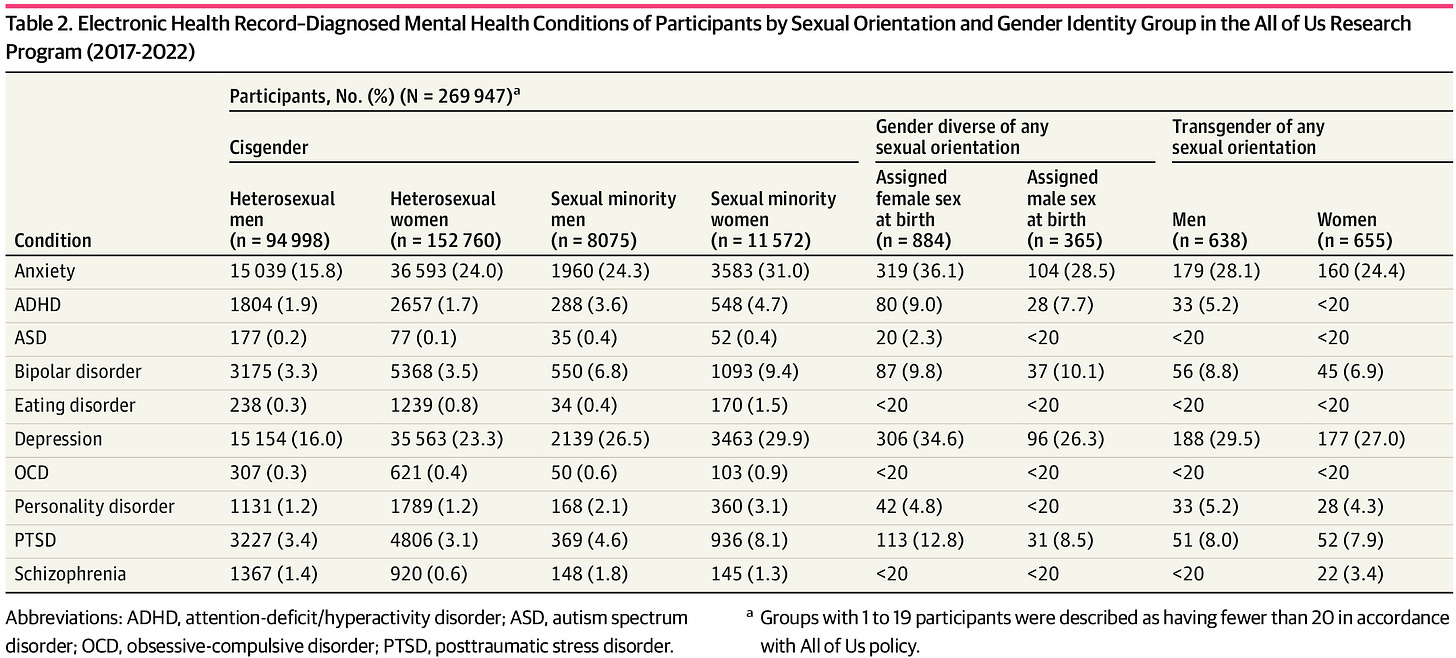
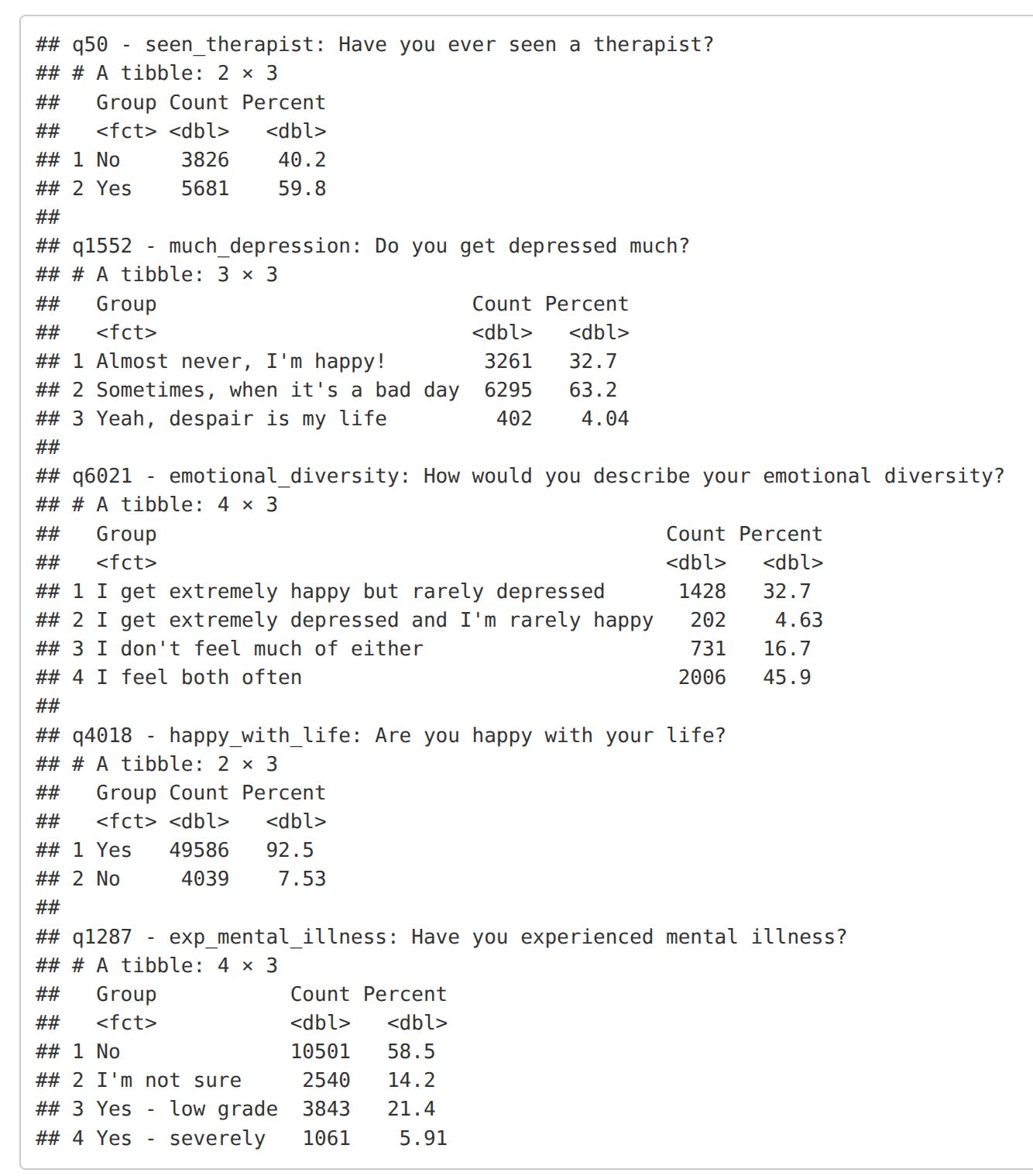
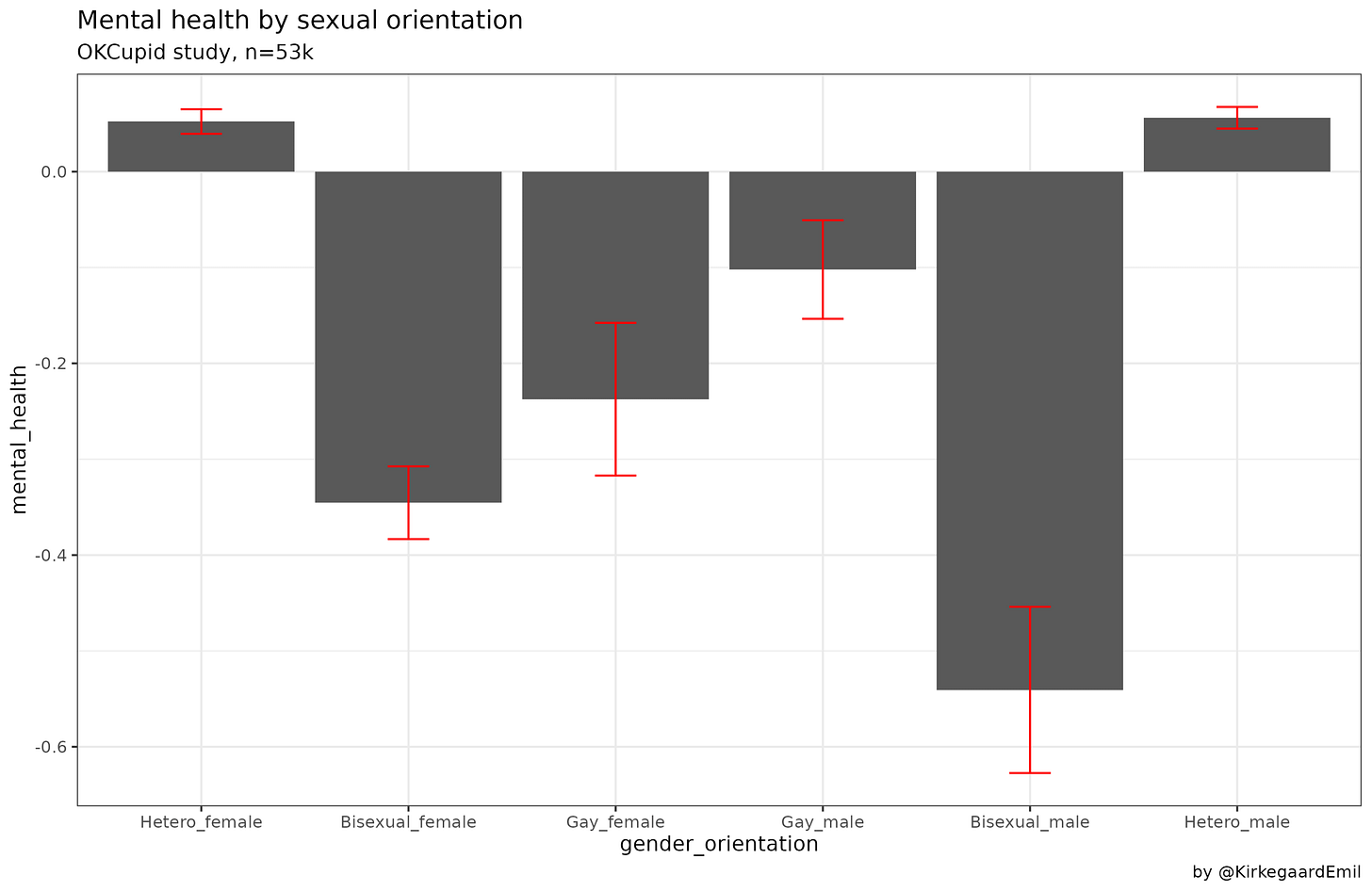
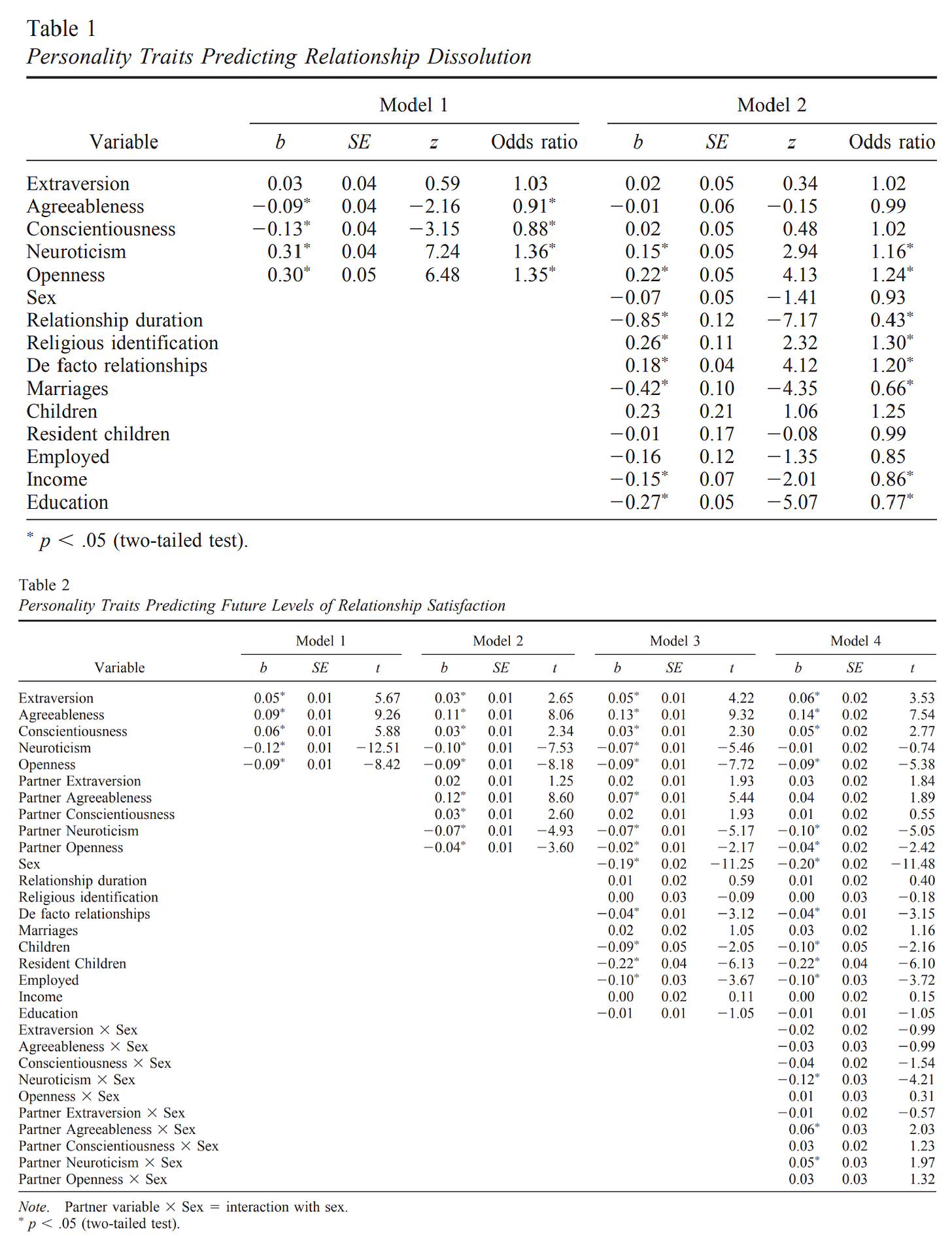
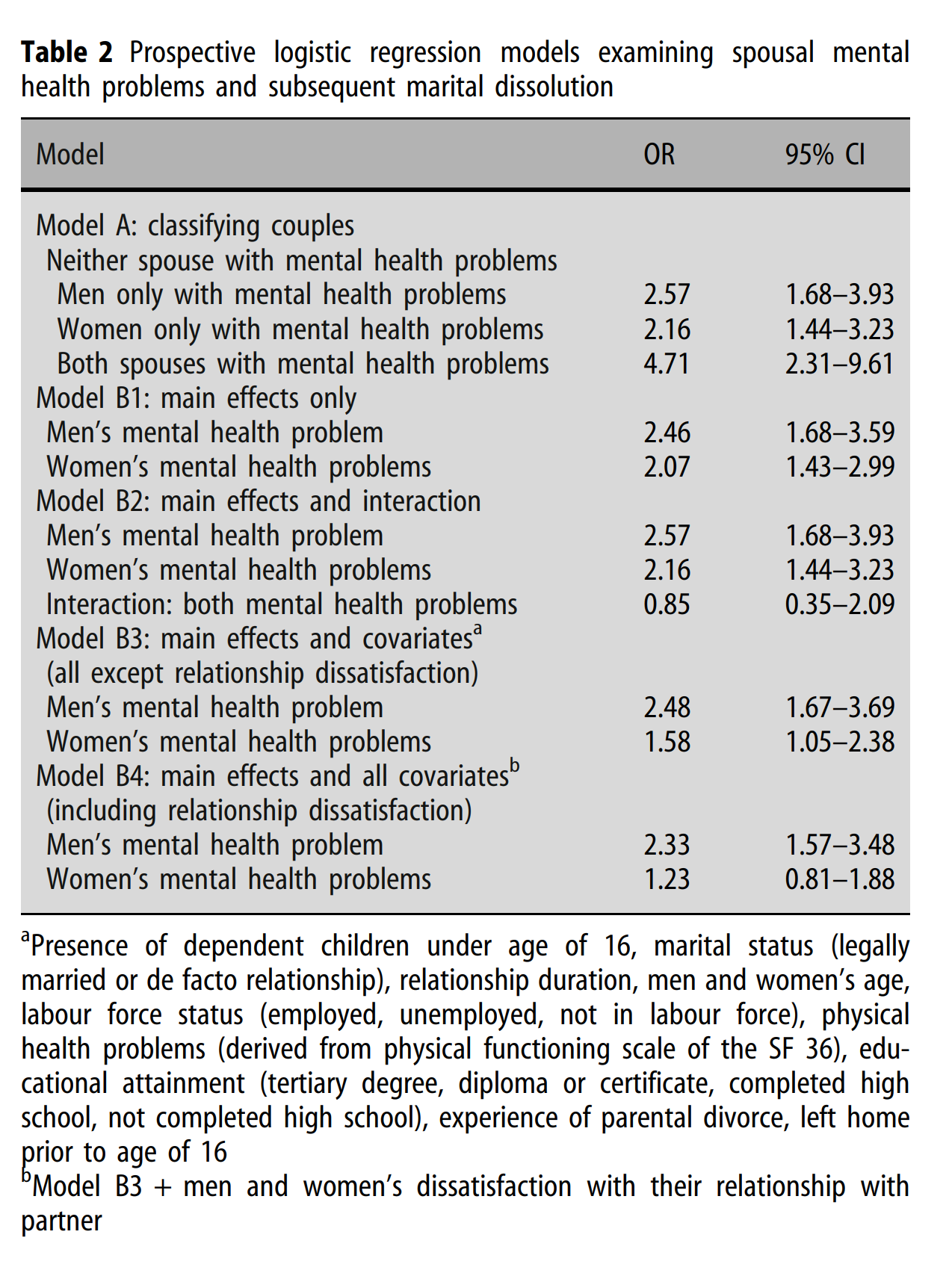
Big five, not big give 😄
"lesbians ... are more prone to (other) mental health problems"
Good clarification there.